COLDITZ
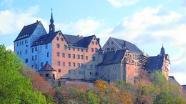
If you ask a Dutchman what Colditz is, he will most likely shake his head. Maybe some people remember that it was on television long ago ("Wasn't it something with a castle?") but that's it. But if you put the same question to someone from the United Kingdom, you get the right answer immediately: Colditz was that special prisoner of war camp from where the most spectacular escapes took place.
The camp, the official German name was Oflag IV C, was a Sonderlager ("special camp") where persistent escapers were imprisoned. It was an international camp, populated by officers from Britain, the Netherlands, France, Poland, Australia and even some from Belgium.
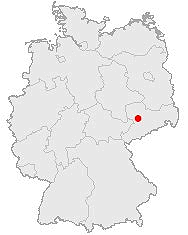
Colditz is a little town in the eastern part of Germany (in the federal state of Saxony), in the triangle formed by Leipzig, Dresden and Chemnitz. The town is situated along the river Zwickauer Mulde which is a branch of the Elbe. The castle, in which the camp was housed, lies on a hill at the east side of the town and can be seen from great distance. The Germans thought that it was impossible to escape – how wrong they were!
The castle is very big and is situated around two court yards. After passing the entering gate, you cross the dry moat, then the tower and you arrive at the first court yard. This was the so-called German courtyard because the German administration was located here. If you walk on, you pass a gallery, at the end turn right and through the last gate you enter the prisoner's courtyard. Apart from the quarters where the prisoners lived, you will find here the kitchens, the chapel, the sick bay, the parcel's room and the solitary confinement cells.
My interest in Colditz started in 1974 when the BBC TV-series was broadcasted in Holland for the first time. As a young boy I was impressed by the "soldiers" who tried to escape from an old castle. In the same time a book about Colditz was published in Dutch. It was the story of Reinhold Eggers, the German Security Officer. This was my first Colditz book, at that time I could not imagine that many more books would follow!
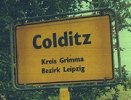
In 1986 I visited the German Democratic Republic (GDR) and I took the opportunity to visit Colditz. Om 15 July I travelled by bus from Leipzig to Colditz which took one and a half hour. When approaching Colditz, it was most exciting to see the castle from a distance. After arriving in Colditz, one of the bus passengers, an inmate of Colditz, showed me the way to the Heimatmuseum (local museum) where I was received very friendly. After telling the reason for coming to Colditz, I was amazed to hear that I was the third Dutchman visiting Colditz that year!
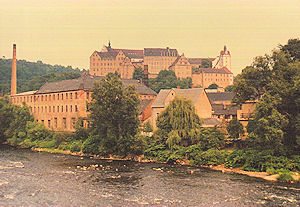
The castle, which was in use as a hospital and an elderly home, was very neglected (as were many things in the GDR) but it looked as it was during the war time. Officially it was impossible to visit the castle but a member of the museum staff, Tilman Alber, showed me the both court yards. That museum was mostly about the history of the town, just one small room was dedicated to the war time of the castle. This was remarkable as "war" was a sensitive matter in the GDR.
The photograph is taken during that first visit in 1986. It shows the castle, seen from the bridge which crosses the Zwickauer Mulde. The former pottery on the left has been demolished in 2001, but the house at the right survives. Compare this photograph with the recent picture in the photo gallery.
After all it was a very impressing experience which I remember very well. The GDR was grimy, neglected and sometimes even depressing. Everywhere you saw flags and propaganda paroles. The air was polluted with the smell of brown coal and Trabants (East German made cars with two-stroke engine). Nobody could imagine that this would change three years later. The falling down of the Berlin Wall was a surprise for everyone, including myself.
Shortly after my visit I got in touch with Kenneth Lockwood, one of the British prisoners. I corresponded with him for a long time, the last few years in a modern way: by e-mail. Kenneth Lockwood passed away on 8 October 2007, aged 95.
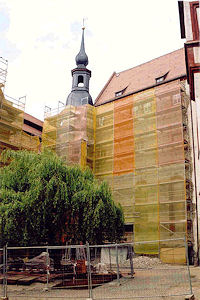
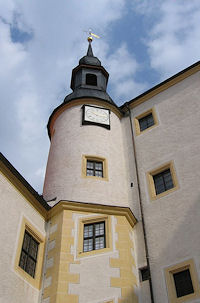
After the German reunification I have been back to Colditz about 10 times (the last time was in October 2008) and I am sorry to say that the then atmosphere is disappeared. At present the castle undergoes a thoroughly restoration to bring the outside back in the medieval view. However, nearly all visitors coming to Colditz are interested in the period that the castle was a POW camp. Let me be clear: it is good that the castle is refurbished but most tourists come for that special period. The left photograph shows the prisoner's court yard (nearly unrecognisable) during the renovation works in 2002. The right picture shows the corner with the chapel's tower in 2005, after restoration.
The Escape Museum (now situated in the castle, partially in the former Guard House) is worth seeing and several escape sites can be seen during the guided tour, including the well known French tunnel. But anyone who knows the photographs from the war time and see the castle now, will be disappointed. I am glad I saw the castle before the big renovation started. Yet it is a special experience, every time again, to be at the place where it all happened.
After my 1986 visit I started collecting books about Colditz. It is amazing how many books are written about this POW camp. I possess several books which are signed by the author, giving these books an added value. In 1988 I visited Australia where I met Jack Champ who has written a book as well. Of course I received a signed copy of his book and I kept in touch with him until he passed away in 1998.
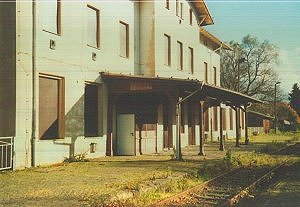
The economical situation in the former GDR is very bad and this can easily been spotted in Colditz. Once there were a beer brewery, a big porcelain factory and some potteries. That is nearly all gone which resulted in a huge unemployment. Many people decided to move to the western part of Germany. In 2003 the number of abandoned houses was remarkable.
The only salvation for Colditz is the tourism. After the fall of the Iron Curtain it has become much easier to visit this area. The majority of the visitors are British (even a school child knows the name Colditz), followed by the Dutch. German visitors are rare and they are for obvious reasons not interested in the former POW camp. Poles and French are rarely seen in Colditz.
Most tourists only stay for one day as there are little facilities to stay a night over. Hotels and guest houses are rare and the number of restaurants and pubs is low. If you have no car, the only way to reach Colditz is by bus because the railway closed in 2000. Due to the economical situation in Germany it is not likely that this will all change soon.
A private society for people with a personal interest in Colditz was established in the United Kingdom in 1991 and the already mentioned Kenneth Lockwood brought this to my attention. I joined soon and for many years I was the only Dutch member. Started in 1993 there are meetings twice a year in London which I attended all but one. London is easy to reach: from Rotterdam The Hague Airport it is just one hour flying. I always stay in a little hotel in Gower Street (Bloomsbury).
First the meetings were held in an auctioneer house not far from Oxford Street but since some years in the Imperial War Museum. At every meeting an ex-prisoner is invited to tell his story. This is becoming increasingly difficult and many former speakers are passed away in the mean time. Several members of the society have become good friends and thanks to e-mail I am in touch with them.
Started from scratch, the society has now more than 100 members. Most of them come from Britain but we have also people from the Netherlands, USA, Canada, Australia, New Zealand, Denmark and Belgium so the society is international, just as Colditz was. Several members are related to ex-prisoners.
The society publishes a newsletter at regular times and the members are assumed to contribute. Writing is not everyone's favourite but I like it so I have already written articles several times. Of course this must be in English but that is not a big problem for me. Apart from that, I am fluent in the German language which makes it easy to get in touch with the people in eastern Germany; English is not widely spoken and understood.
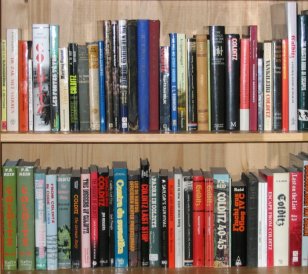
Collecting Colditz books remains my favourite occupation, as far as time permits. I regularly visit book fairs and second-hand book shops. Nowadays the internet is a finding place for books as well but this is less exciting than finding a book in a shop.
There are many books published about Colditz, click on "books" at the bottom of this page to see a selection.
Much information about Colditz can be found on the internet, click on "links" at the bottom of this page to go to a separate page with Colditz-related links.
When searching for "Colditz" on the internet, you will sometimes be surprised. For instance, in Finland exists a hard rock band Colditz. It seems a strange combination but that band is really named after the prisoner of war camp! During my holidays in Finland in July 2005 I met one of the members of the Colditz band, click here to read more about the band and my visit.
If you have seen the TV-series or read one or more books, I can only recommend you to visit Colditz. I can't describe the feeling when you stand in the court yard where once the prisoners walked around, you must experience it yourself.